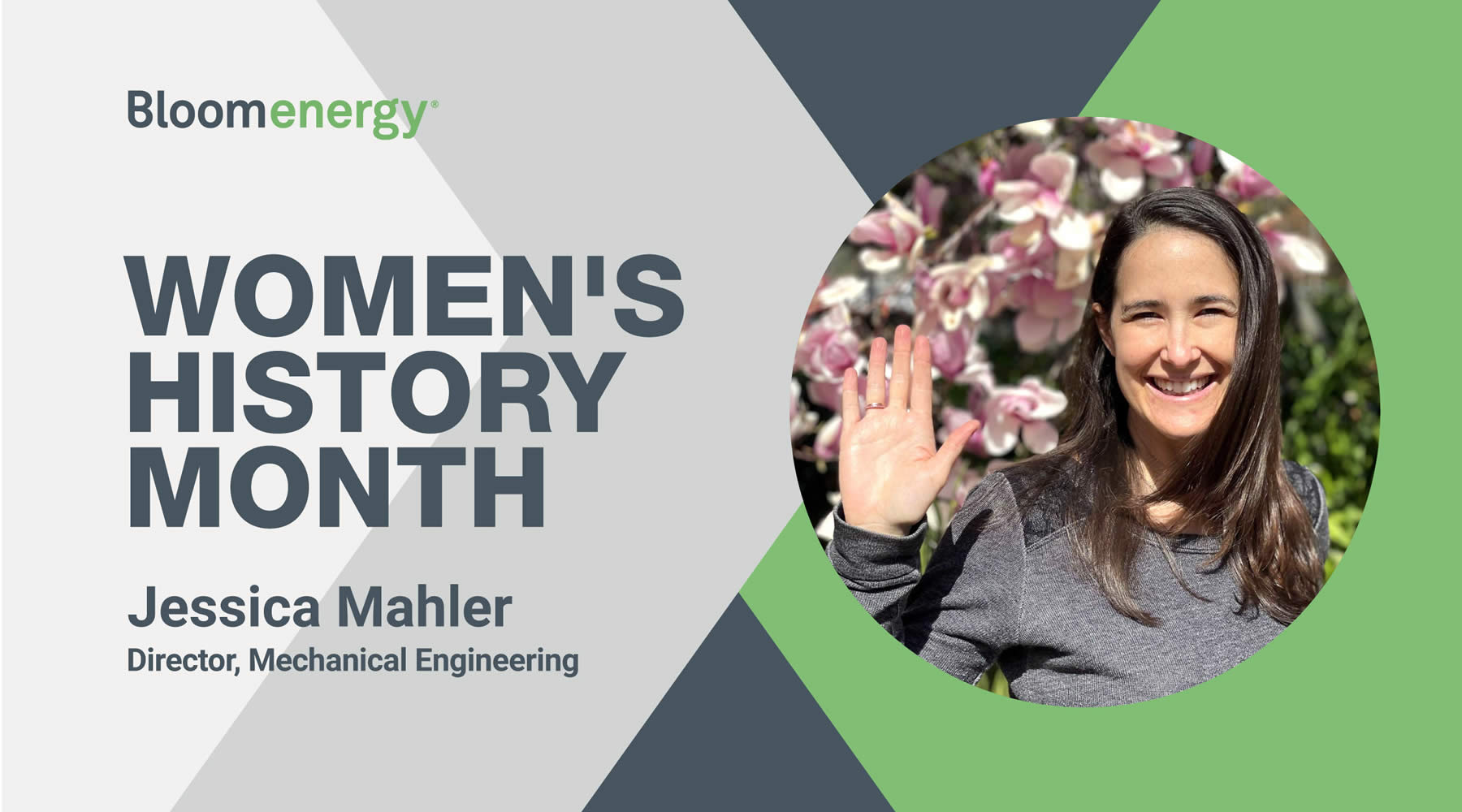Here at Bloom, our very own women shine in leadership roles across our business.
That’s why in honor of International Women’s Day and Women’s History Month we’ll be spotlighting many of the talented women working at Bloom Energy.
In this four-part series, women of Bloom will share their unique stories and perspectives alongside the International Women’s Day theme of #ChooseToChallenge, showing solidarity and commitment to challenging inequality, calling out bias, developing a platform for discussion, and helping to forge an inclusive world. Enjoy the first installment in our series below.
Jessica Mahler – Director, Mechanical Engineering
Jessica has been designing, building, and deploying distributed energy generation solutions at Bloom Energy for over a decade. She currently manages a team of mechanical, component development, and chemical engineers focused on system engineering. Jessica is on the board of Stanford Cap and Gown. Jessica holds bachelor’s and master’s degrees in mechanical engineering from Stanford University and lives in Palo Alto with her husband and two daughters.
Watch the video below to hear Jessica’s perspective on being a woman in a male-dominated industry, and how she’s challenging the status quo not only as an engineer, but also as a mother paving the way for the next generation of girls in STEM fields.
This year’s theme for International Women’s Day is #ChooseToChallenge. How do you choose to challenge and call out gender bias and inequality, celebrate women’s achievements and/or help create an inclusive world?
As a woman in mechanical engineering in alternative energy, I #ChooseToChallenge by breaking the conventional stereotype of how an engineer should look and act. For me, this is a one-by-one process, as I build connections with my team, my co-workers and vendors on a technical level.
Very early on in my engineering career, I called a hardware store looking for stainless steel pipes for one of my first projects at Bloom Energy. Hearing my voice, and likely making a snap judgement, the salesperson asked me why I needed ‘shiny’ pipes and proceeded to tell me that standard steel would suit my needs. Instead of getting frustrated that he initially judged me from the sound of my voice, I took the conversation to his expertise, explaining with confidence that I needed the stainless steel because it was corrosion-resistant, not because it was shiny. After an awkward pause, he helpfully pointed me in the direction of another store that carried what I needed. I had made a connection with him by confidently engaging on a technical level. I’ve used this as my model for challenging gender bias – by confidently and competently engaging one-by-one to break any long held stereotypes.
In my community, I celebrate women’s achievements by being on the board of Stanford Cap and Gown. Cap and Gown is an organization that cultivates and empowers women leaders by bringing together members of the Stanford community who demonstrate and celebrate women’s leadership. We host quarterly service and networking events with both student leaders and alumnae where we create a supportive community where women leaders can excel.
And, lastly the third part of this question – I’m helping create a more inclusive world at home where I am a mom to two young girls who have only known me as an engineering professional. Again – creating personal connections in my own family where children can see that the engineering field can be inclusive. For the last year, my girls have experienced their working mom first-hand, seeing me in my home office at my computer and hearing me leading meetings with my team. We have visited installed Bloom Boxes, where I show them with pride the product that Bloom Energy produces. We talk about the trial and error process of engineering, how it is okay to fail the first time around just as long as we learn from our mistakes and try again. We talk generally about challenges that my team faces, and how I spend time trying to help others overcome those issues. I can only hope that they will take my example and see that engineering can include all types of people, including girls.
What has been your experience trying to hire women in engineering and cultivate a diverse team?
Hiring a diverse team takes a close partnership with the recruiting team, as we work together on a holistic approach to each candidate. For me, it is important to understand what each person can bring to the team, whether it is a highly technical background, a potential for leadership, or an ability to create strong intrapersonal connections with a cross-functional team. Also, on our interview panels, I consciously bring a diverse panel to both get varied opinions on the candidates, and share Bloom’s diversity with the candidates.
As both a mother and career professional, what is your perspective on work and life balance?
I hope it’s no secret that I really love what I do. Creating awesome products using engineering problem solving, and also helping my own team to overcome their own challenges is what drives me to continue working. However, when the end of the workday rolls around, I know my children are counting on me to spend a few precious hours with them before bedtime. Pre-pandemic, it was a sprint to leave the office on time to pick up my children, feed them dinner, and get them to bed at a reasonable hour. While I would work at home as needed, hopping on late-night meetings or responding to email on my phone, the physical separation from work helped to define work/life boundaries. After March 2020, without that end-of-day sprint, with a dedicated home desk and no defined activities on the weekend, the “extra” time went right back into my work, where I would expend all my energy and then have nothing left in my reservoir for family time. Even with all the articles written, it took me a while to recognize this behavior, and since then I’ve tried to think about and implement things I can do to get back to some aspects of pre-pandemic life.
Do you think women bring a unique perspective to engineering, especially in the energy space? How/why/why not?
I can’t speak for all women, but what I bring is a collaborative approach to engineering product design. It is my personality to seek my team’s diverse opinions before deciding how to proceed on complex product challenges. I rely on the broad knowledge of my team members, woven with my own breadth of experience to move our product down the right path.
Who is your favorite historical female figure? What do you admire about her?
A tireless advocate for gender equality, a mom, and not an engineer: Ruth Bader Ginsberg. I will say that it was hard for me to think about a favorite historical engineering figure, perhaps because it wasn’t so much part of my history books or education growing up. I can only hope that when my girls are asked this question 20 years from now, they’ll have the answer for this question down!



